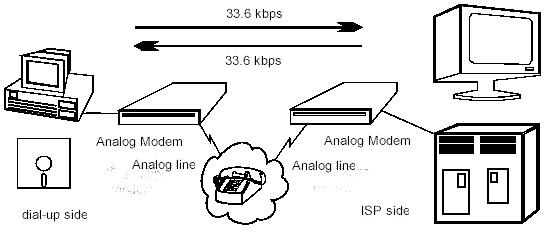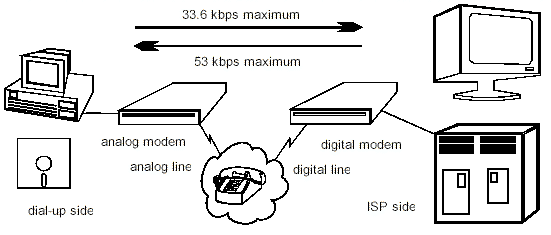
Traditional dial-up to ISP connection uses identical modems
The 56 kbps modem is an interesting concept in data communications over the phone line. There is a departure from the traditional concept of having two identical modems present at both the receiving side and transmitting side. 56kbps modems are different devices at the ISP (internet service provider) side and the dial-up side (joe user).

Traditional dial-up to ISP connection uses identical modems
Traditionally, a dial-up connection uses two identical modems with the same communication standard at both ends. This method of communication reached a transfer limit of 33.6 kbps with the V.34bis standard.
In order to increase the transfer rate, the "modem" connection at the ISP side was "modified" to eliminate the analog to digital conversion. The modem at the ISP end uses only digital communication while the dial-up user's modem retains the analog to digital characteristics required to use the local loop. By eliminating one of the analog to digital conversions required in a traditional modem connection, the transfer rate is increased in the download direction - from ISP to dial-up user. This requires that the ISP has a special V.90 compliant digital modem and also digital lines to the telephone company switch.

V.90 standard dial-up to ISP connection showing digital modem
Maximum upload transfer rate is 33.6 kbps from the dial-up connection to the ISP and the maximum download transfer rate is 53 kbps (not 56 kbps as advertised) from the ISP to the dial-up connection. These transfer rates are available under ideal situations and not every local loop connection will support these speeds. Most phone lines can support the maximum upload transfer rate of 33.6 kbps but the majority of phone lines seem to be able to support download transfer rates of about 43 kbps. Again this will vary depending on the quality and age of the dial-up connection.
Initially, there were two competing standards for the 56 kbps modems: Rockwell's K56 and US Robotics' X2. Eventually, the ISU (International Standards Union) came out with the current V.90 standard which both Rockwell and USR now follow. If you have a Rockwell K56 or USR X2 standard modem, you should be able to go to their respective websites and download an upgrade.